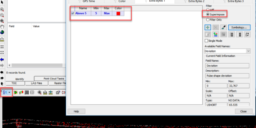GeoCue Support » Drone, Mobile and Handheld Mapping » TrueView Tools, Tips and Workflows » Page 7
While attempting to run POSPacCloud to process the trajectory solution for a TrueView 3DIS, the user encounters an error message stating, “UPLOAD_FAILED”. Update to TrueView EVO/LP360 Drone v2022.1.39.0 or later and install POSPacCloud v0.0.67 or later. Both installers are available from the Downloads -> Software section when you log into your Reckon account website. These…
This procedure applies to users running POSPac Desktop (Classic) processing and is not applicable to POSPacCloud or DGaaS sensors. LP360 Drone will attempt to automatically set the start/end time of POSPac sensor trajectory processing based on the kinematic motion of the sensor. This works in the vast majority of cases. However, there are times where…
Relative vertical accuracy, or flight line offsets, or the swath-to-swath fit between flight lines or drive passes can be qualitatively assessed using dz images. Or quantitatively assessed by exporting and analyzing the values. The USGS LiDAR Base Specification has evolved over the years with some different recommendations for evaluating interswath (overlap) consistency, and there are…
Attempting to save an LP360 project results in “An error occurred updating the Project Catalog with Project:”, followed by “Detail: Error: Unable to open Projects File. Project not added to list. C:\ProgramData\LP360\PMProjects.json”. The global projects file, “%ProgramData%\LP360\PMProjects.json”, used by the LP360 Project Manager was created with administrator permissions when LP360 or TrueView EVO first launched…
Some LP360 Point Cloud Tasks (PCT’s) were originally designed for older manned lidar datasets, which have significantly lower point density than modern sUAS datasets. TrueView and other sUAS sensors have the capability of producing much denser point clouds, so these processes can take much longer if running on the entire dataset. A common strategy and workflow…
TrueView 3DIS (3D Imaging Systems) produce images and positional information which can be imported into TerraPhoto for orthomosaic generation, point cloud colorization, powerline workflow – image view, etc. Here we’ll review the process for importing this data into TerraPhoto, which includes: exporting a photo package from TrueView Evo/LP360 Drone, rename the images for import into…
Running Metashape for EVO (MfE) errs almost immediately with a warning in the STDERR section of the processing log that states, “Warning: disabled [m/n] reference records with zero GPS coordinates”. The warning indicates there are one or more photocenters included in the layers submitted for the MfE job where the GPS Coordinates in the EXIF…
Classify by Elevation Quartiles In the Classify by Statistics PCT, the user can set the output of outliers and quartile classification using the standard output class/flag dialog. A little info regarding quartiles: https://byjus.com/maths/quartiles/. The section applicable to Quartile classification is shown in Figure 1: This classifier works as follows: The area to be processed (as determined…
An unknown antenna model can lead to biases in your trajectory solution since the antenna phase center (APC) to antenna reference point (ARP) offsets cannot be taken into consideration. If you are using a GNSS base antenna you have not used before, you should check the Base Station Information section of the POSPac report (Figure…
Officially introduced in the LAS v1.4 specification, Extra Bytes is a mechanism which allows a developer to define extra data fields of various types. They are a means to extend the LAS format to add additional information to each point, literally

